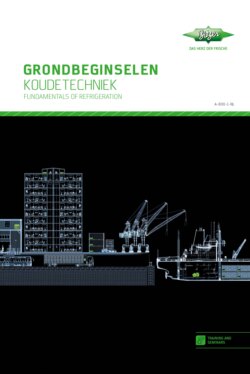Читать книгу GRONDBEGINSELEN KOUDETECHNIEK / In twee talen Nederlands/Engels - Volker Stamer - Страница 19
На сайте Литреса книга снята с продажи.
Оглавление1.4
Enthalpie, veranderingen van
aggregatietoestand, terminologie
De aggregatietoestand van een stof kan bij continue
verhitting of afkoeling veranderen. De fysische staat
van een stof hangt af van de temperatuur en de druk
die erop wordt uitgeoefend. Tijdens de verandering
blijft de temperatuur constant totdat de overgang van
de ene naar de andere aggregatietoestand is voltooid.
Enthalpie H werd vroeger aangeduid met de term „warmte-inhoud“. Enthalpie geeft aan hoeveel warmte (in relatie tot een bepaalde temperatuur) een stof bevat.
Fig. 11 toont het verband tussen de temperatuur
en de specifieke enthalpie van een stof voor alle
aggregatietoestanden en faseovergangen (met water
als voorbeeld).
Fig. 11 Temperatuurenthalpiediagram voor water bij atmosferische druk (pamb = 1,013 bar)
Temperature-enthalpy diagram for water at atmospheric pressure (pamb = 1.013 bar) [TWK]
Als diepgevroren ijs (temperatuur: -18 °C) voortdurend
van warmte wordt voorzien, neemt de temperatuur van
het ijs aanvankelijk toe. Wordt het smeltpunt (0 °C)
bereikt, dan blijft de temperatuur constant en het ijs
verandert in water. De benodigde warmte-energie om
het ijs om te zetten in water wordt smeltwarmte q ge-
noemd. Zodra alle watermoleculen uit het vaste kristal-
rooster zijn opgelost en zich vrij in het (vloeibare) smelt-
water bewegen, blijft de temperatuur stijgen zolang er
sprake is van warmtetoevoer. Dit proces houdt aan tot
een volgende verandering in de aggregatietoestand
wordt bereikt, de overgang van vloeibaar naar gasvor-
mige toestand. Dit proces wordt verdamping genoemd
1.4
Enthalpy, changes in physical state,
terms
A substance may undergo several changes in phys-
ical state when heated or cooled continuously. The
physical state of a substance depends on its tempera-
ture and the pressure acting on it. During the change
in physical state, the temperature remains constant
until the entire substance has changed from one state
to the other.
Enthalpy H was previously known under the term ‘heat content’. Enthalpy defines how much heat (relative to a specific temperature) a substance contains.
Fig. 11 shows the relationship between the tempera-
ture and the specific enthalpy of a substance for all
physical states and phase changes (using water as an
example).
If ice from the freezer compartment (temperature: –18°C)
is constantly supplied with heat, the temperature of the
ice initially increases. When the melting point (0°C)
is reached, the temperature remains constant and the
ice begins to melt. The heat energy required to melt the
water is called latent heat of fusion q. Once all the
water molecules have dissolved from the solid crystal
lattice bond and can move freely in the melt (now only
liquid), the temperature rises with further heat input.
It does this until a further change of physical state is
reached, the transition from the liquid to the gaseous
state. This process is called evaporation (at 100°C for
water) and the energy required for this is the heat of
Specifieke enthalpie in kJ/kg
Specific enthalpy in kJ/kg
Grondbeginselen thermodynamica // Fundamentals of thermodynamics
21
